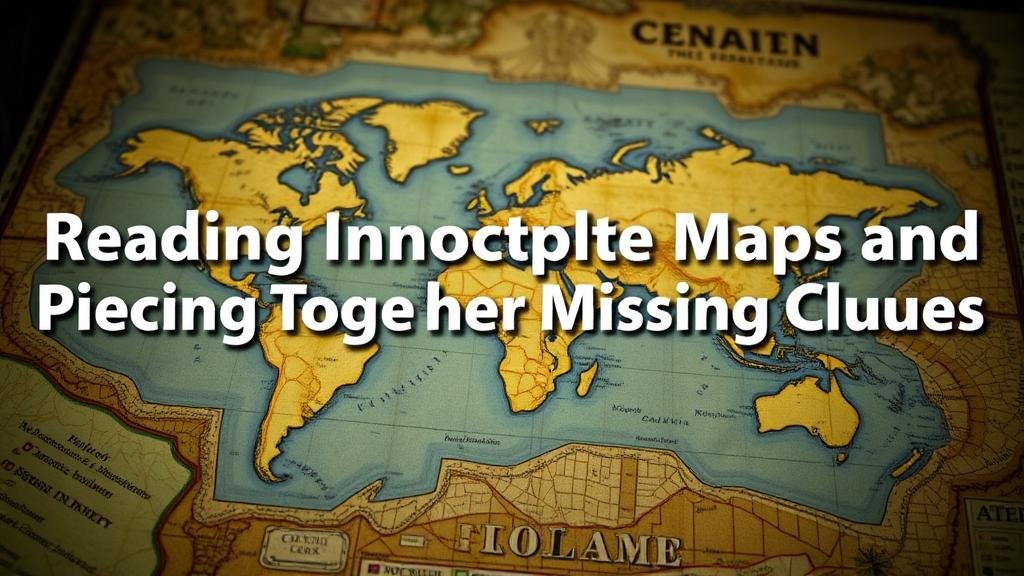Reading Incomplete Maps and Piecing Together Missing Clues
Reading Incomplete Maps and Piecing Together Missing Clues
Effective navigation and understanding of environments often depend on the ability to interpret maps. But, reading incomplete maps poses unique challenges that require analytical skills, problem-solving capabilities, and an understanding of context. This article explores how to effectively piece together the missing clues in incomplete maps, emphasizing strategies, real-world applications, and the cognitive processes involved.
The Nature of Incomplete Maps
Incomplete maps typically lack certain details due to various factors such as changes in the environment, limitations in data collection methods, or intentional design choices. Understanding these maps requires not just reading the available information but also making educated inferences based on context. For example, a tourist map might lack recent tourist attractions but still provides a general layout of the area, allowing one to infer possible pathways to find new spots.
Impact of Missing Information
Missing elements can significantly affect navigation and understanding. The absence of crucial data may lead to misinterpretations. A good example is how cyclists might read road maps differently than motorists, focusing on bike trails that may not be indicated. So, recognizing the type of audience the map serves is vital for proper interpretation.
Strategies for Interpreting Incomplete Maps
To navigate effectively with incomplete maps, consider employing the following strategies:
- Contextual Analysis: Understanding the broader context provides valuable clues. For example, if a map lacks specific stores, knowing the area is known for particular shopping trends can guide expectations.
- Cross-Referencing: Utilizing additional resources such as local guides or online platforms can supplement missing information. A case in point is using Google Maps for real-time updates while using a physical map for orientation.
- Inferences and Logical Deduction: Making educated guesses based on remaining clues helps fill in gaps. A map highlighting major intersections can lead one to assume that smaller streets connecting these points might exist.
- Engagement with Locals: Engaging with local inhabitants often reveals information unavailable on the map. Locals may know shortcuts or new developments that are not represented.
Cognitive Processes in Map Interpretation
Reading incomplete maps taps into various cognitive processes, including spatial awareness, pattern recognition, and critical thinking. Spatial awareness involves visualizing and understanding the physical space represented, while pattern recognition helps to identify familiar symbols or layouts that can guide interpretations. Plus, critical thinking comes into play when determining the best course of action based on the maps incomplete information.
Real-World Applications
The ability to read incomplete maps and deduce missing information has practical applications across several fields:
- Urban Planning: Urban planners often work with dated maps or aerial images lacking current developments. They must piece together information via inspections, surveys, and community feedback to create effective urban designs.
- Disaster Management: In the aftermath of a disaster, responders frequently rely on outdated maps. must assess the situation on the ground, often collecting information through reconnaissance missions and communicating with local residents to identify hazards and access routes.
- Outdoor Navigation: Hikers using topographic maps may find some trails unmarked. They often employ a combination of compass readings and environmental cues to navigate safely.
Conclusion and Actionable Takeaways
Understanding and interpreting incomplete maps is an invaluable skill in various disciplines, from emergency response to urban development and outdoor exploration. To develop this capability, cultivate an analytical approach that combines contextual understanding, cross-referencing, deduction, and community engagement.
There are several actionable takeaways for enhancing your map-reading skills:
- Always consider the context of the map and all available supplementary resources.
- Practice proactive communication with local individuals to fill information gaps.
- Employ critical thinking and logical reasoning when deciphering missing elements.
By mastering these strategies, individuals can become more adept at navigating the complexities presented by incomplete maps, leading to improved situational awareness and effective decision-making.



